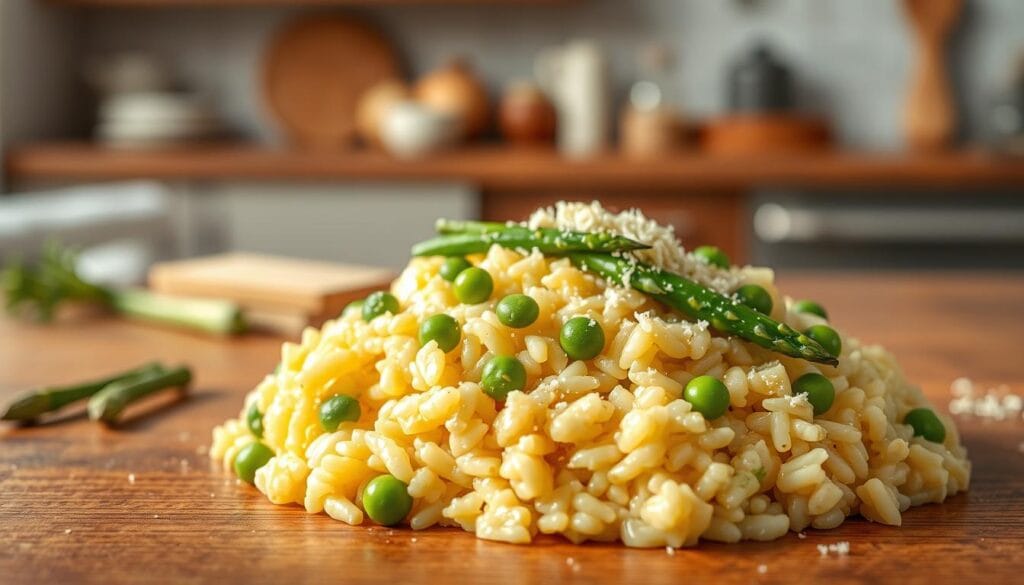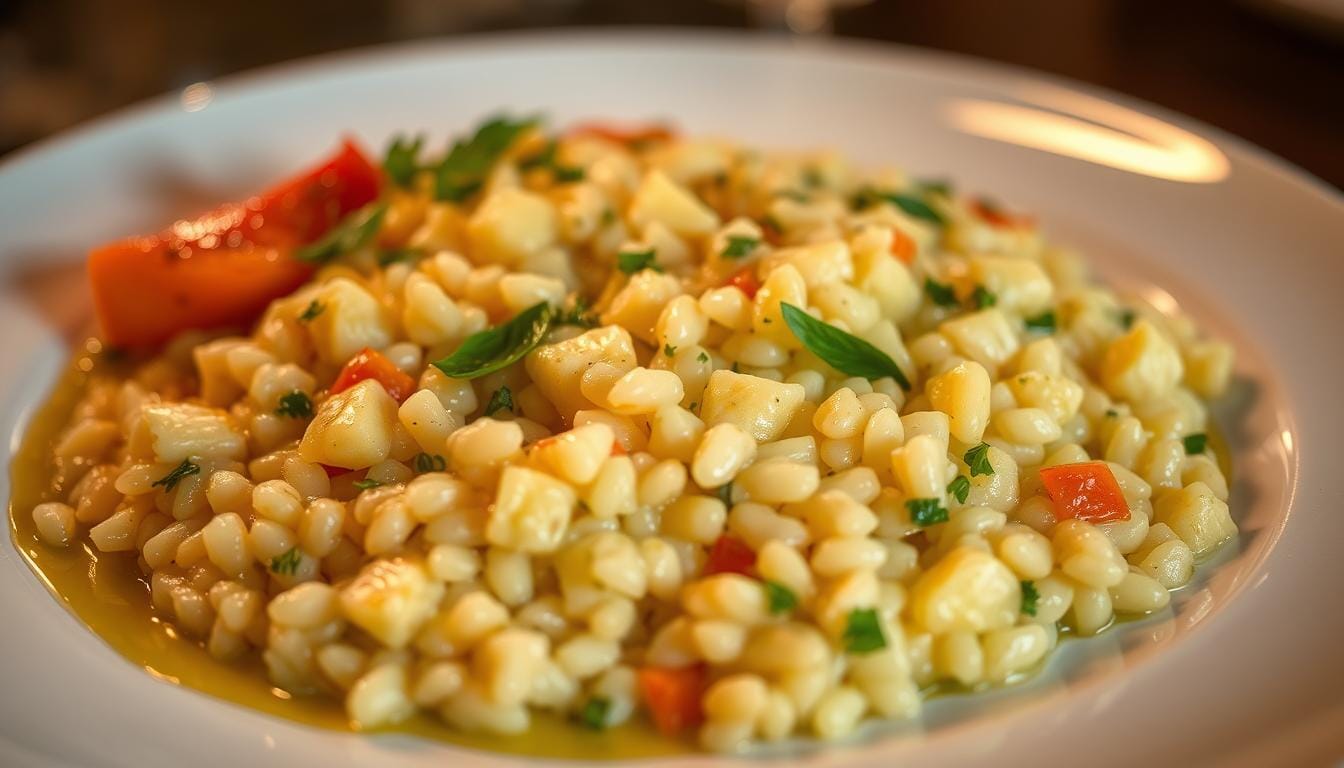When you think about making risotto, you might ask: is gluten free risotto? The answer depends on the ingredients, especially the rice and broth. Traditional risotto uses Arborio rice, which doesn’t have gluten. This makes it safe for those who can’t eat gluten. But, some recipes might include gluten, so always check the ingredients.
In this guide, we’ll talk about what makes a dish gluten-free. We’ll also cover the basics of traditional risotto. Plus, we’ll give you tips for making risotto gluten-free at home.
Key Takeaways
- Traditional risotto is made with Arborio rice, which is naturally gluten-free.
- A serving of gluten-free risotto contains approximately 196 calories and 9g of total fat.
- Gluten-free risotto brands include Lundberg Family Farms, Risodoro, Vigo, Trader Joe’s, and Cascina Belvedere.
- Leftover gluten-free risotto can be stored in an airtight container in the refrigerator for up to 3 days or frozen for up to 3 months.
- Products labeled “gluten-free” must contain less than 20 parts per million (ppm) gluten.
- Whole grains, such as rice, quinoa, and millet, are naturally gluten-free and can be part of a balanced diet.
- When making gluten-free risotto, it’s crucial to use gluten-free chicken broth and check the labels of all ingredients to ensure they meet the 20 ppm standard.
Understanding What Makes a Dish Gluten-Free
To make a gluten-free dish, you need to know what gluten is and where it’s found. Gluten is a protein in wheat, barley, and rye. It’s in many foods. But, people with celiac disease or gluten sensitivity must avoid it to stay safe.
Looking into gluten-free recipes means checking the ingredients and cooking methods. Making gluten-free risotto can be tricky because traditional recipes include gluten. But, with the right ingredients and techniques, you can make tasty and safe gluten-free risotto.
What Is Gluten?
Gluten is a protein in wheat, barley, and rye. It’s found in many foods. Knowing this helps in making gluten-free dishes.
Common Sources of Gluten
Gluten is in wheat, barley, and rye, and foods made from them like bread and pasta. Also, be careful of hidden gluten in sauces, seasonings, and processed foods.
Cross-Contamination Risks
When making gluten-free dishes, avoiding cross-contamination is key. Use separate utensils and surfaces to prevent gluten from getting into your food.
Grains like rice, quinoa, and corn are good for gluten-free dishes. They help make gluten-free risotto and other tasty dishes. By knowing what makes a dish gluten-free and being careful, people with gluten issues can enjoy many safe foods.
The Basic Components of Traditional Risotto
Traditional risotto is simple yet essential. It usually has risotto ingredients like Arborio rice, white wine, and stock. These are the core of a great risotto, and their quality matters a lot.
There are many risotto variations by adding unique flavors and ingredients. Some of the best risotto dishes mix traditional ingredients with creative flavors.
A classic risotto recipe might use 200 grams of Arborio rice, 473 ml of chicken broth, and 60 ml of white wine. Making risotto involves adding broth slowly to the rice. This helps release starch and makes the dish creamy.
Popular risotto variations include Risotto al nero di seppia with cuttlefish ink and Risotto alla milanese with saffron. These dishes show how versatile risotto can be.
If you want to try a traditional risotto or explore new risotto variations, quality ingredients are key. Paying attention to the cooking process is also important. With practice and patience, you can make delicious, authentic risotto that will wow everyone.
Is Risotto Gluten-Free? The Definitive Answer
To figure out if risotto is gluten-free, we need to look at its main ingredients. Traditional risotto uses Arborio rice, which doesn’t have gluten. But, some recipes might include gluten, and restaurants could have cross-contamination.
If you’re thinking about making gluten free risotto, knowing about risotto allergens is key. To avoid gluten, buy rice that’s labeled gluten-free. This is especially important for those with severe gluten intolerance.
Here are some important things to remember about risotto and gluten:
- Arborio rice is naturally gluten-free, making it safe for those with celiac disease or gluten intolerance.
- Cross-contamination can happen during processing, packaging, or cooking, so be careful.
- Buying gluten-free rice is a good way to ensure safety, especially for those with severe gluten intolerance.
In short, traditional risotto can be gluten-free if you use gluten-free ingredients and take precautions. It’s important to be aware of risotto allergens and avoid gluten exposure. By choosing the right ingredients and being careful about cross-contamination, you can enjoy a tasty and safe gluten free risotto dish.
Understanding Arborio Rice and Its Properties
Arborio rice is a top pick for making the best risottos. It’s a short-grain rice, high in starch, which makes it creamy and tender. Plus, it’s naturally gluten-free, perfect for those avoiding gluten.
Arborio rice has low fat and high carbs, and it’s gluten-free. These traits make it a favorite for risottos. It’s safe for those with gluten intolerance and tastes great. Here are some key facts about Arborio rice:
- Low in fat, with approximately 6 grams per serving
- High in carbohydrates, with about 79 grams per serving
- Naturally gluten-free, making it a great option for gluten free grains
- Good source of potassium and fiber
Arborio rice is a top choice for making the best risottos. It’s perfect when mixed with other gluten-free grains and ingredients. Its unique qualities make it ideal for creamy, delicious risottos safe for those with gluten intolerance.
Essential Ingredients for Making Gluten-Free Risotto
To make a tasty gluten-free risotto, pick the right ingredients. You’ll need the right rice, safe broth, and seasonings. Risotto is perfect for gluten free recipes because it uses starchy rice like Arborio, Carnaroli, or Vialone Nano. These are all naturally gluten-free.
Here are some key ingredients to consider:
- Arborio rice: This is the most commonly used rice for risotto and is naturally gluten-free.
- Gluten-free broth: Use chicken or vegetable broth, but check the ingredients to ensure it’s gluten-free.
- Seasonings: Add salt, pepper, and herbs to give your risotto flavor.
When making how to make risotto, use the right liquid to rice ratio. Use 2 cups of broth for every 1 cup of Arborio rice. You can also add vegetables, meat, or seafood for different risotto variations.
By following these tips and using the right ingredients, you can make a delicious gluten-free risotto. It’s a dish everyone can enjoy.
Common Risotto Mistakes That Could Compromise Its Gluten-Free Status
When making gluten free risotto, it’s key to know common mistakes. These can ruin its gluten-free status. Mistakes include using gluten, cross-contamination, and wrong cooking methods.
Choosing the right ingredients is crucial. Arborio rice, for example, must be gluten-free. Also, some ingredients might hide gluten, so always check labels. This way, you can make a tasty and safe gluten free risotto.
Here are some mistakes to avoid:
- Using gluten-containing broths or wines
- Not cleaning equipment and utensils properly to prevent cross-contamination
- Not cooking the risotto long enough to break down the starches
By using the right techniques and avoiding mistakes, you can make a gluten free risotto that’s both tasty and safe. Always check the labels of your ingredients and watch out for allergens.

Tips for Making Perfect Gluten-Free Risotto at Home
To make perfect gluten-free risotto at home, you need the right tools and a clear cooking plan. When learning how to make risotto, remember that the rice type matters a lot. Arborio rice is best because it’s very starchy, making the dish creamy.
For the best risotto dishes, use simple, quality ingredients. For a gluten-free version, pick ingredients without gluten. This means using gluten-free broth and checking all added ingredients for gluten. Here are some tips for making perfect gluten-free risotto at home:
- Use the right type of rice, such as Arborio or Carnaroli, which are high in starch and will give your risotto a creamy texture.
- Choose a gluten-free broth to avoid any cross-contamination with gluten.
- Be mindful of any added ingredients, such as wine or soy sauce, that may contain gluten.
By following these tips and using the right ingredients, you can create delicious gluten free recipes for any event. Always check the ingredient labels to make sure they’re gluten-free. With practice and patience, you’ll master making perfect gluten-free risotto at home.
Popular Risotto Variations That Are Naturally Gluten-Free
There are many risotto variations that don’t have gluten, making them great for those who can’t eat gluten. Some top choices include mushroom, asparagus, and seafood risotto. These can all be made with gluten free grains like Arborio rice.
These risotto variations taste amazing and are simple to prepare. You can also change them up to fit your taste and dietary needs. For instance, adding chicken or shrimp makes the dish more filling and tasty.
There are even more risotto variations to try, like vegetable, meat, and seafood dishes. With a bit of creativity, you can make your own gluten free risotto recipes. These can be both tasty and safe to eat.
Some other best risotto dishes to try include:
- Mushroom and truffle risotto
- Asparagus and parmesan risotto
- Seafood risotto with shrimp and scallops
These dishes use gluten free grains and are perfect for any time. They’re great for special occasions or just a regular meal.
Reading Labels: What to Look for When Buying Risotto Ingredients
When you’re shopping for risotto ingredients, it’s key to read labels well. This is crucial if you’re making food for someone who can’t eat gluten. Look for symbols like the Gluten-Free Certification Organization (GFCO) or the Celiac Support Association (CSA). These show the product is gluten-free.
Also, check the ingredient list for risotto allergens like wheat, barley, or rye. Some foods might have gluten in them, like modified food starch or malt flavoring. Knowing this helps you make tasty and safe gluten free recipes for everyone.
Here are some tips for reading labels and picking the right risotto ingredients:
- Always check the ingredient list for gluten-containing ingredients
- Look for certification symbols from reputable organizations
- Be aware of hidden sources of gluten, such as modified food starch or malt flavoring

By following these tips and watching out for risotto allergens, you can make delicious and safe gluten free recipes. Always read labels carefully and pick products that fit your diet.
Health Benefits of Gluten-Free Risotto
Gluten-free risotto offers many health benefits. It can improve digestion, boost energy, and lower inflammation. Made with Arborio rice, it’s perfect for those with gluten issues.
Some key benefits include:
- Improved digestion thanks to Arborio rice’s easy-to-digest starch
- More energy from the rice’s carbs
- Less inflammation due to low fat and sodium
Gluten-free risotto also provides important vitamins and minerals like iron, niacin, and folate. To create the best risotto dishes, use high-quality, gluten-free ingredients and follow good cooking methods.
Gluten-free risotto is a tasty, healthy choice for those seeking a gluten-free meal. Its health perks and flexibility in cooking make it a favorite among many.
Special Dietary Considerations Beyond Gluten
When looking into gluten free recipes, it’s key to think about other dietary needs. Many people need more than just gluten-free, like vegan or dairy-free options. You can change your risotto to fit these needs by swapping out ingredients.
For example, use vegetable broth instead of regular broth for a vegan risotto. You can also swap dairy for non-dairy alternatives like almond or soy milk. These changes make your gluten free recipes more inclusive, letting you enjoy many risotto types.
Coconut milk or cashew cream are great for adding creaminess without dairy. Try different non-dairy cheeses to find the best one for your risotto. Thinking about these dietary needs lets you make gluten-free risottos for everyone, making meals more fun for all.
With a bit of creativity, you can make gluten free recipes that taste amazing and meet special dietary needs. Whether it’s for yourself or others, remember to consider these needs when cooking. This way, your meals are safe and enjoyable for everyone, no matter their dietary restrictions.
Restaurant Tips: Ordering Gluten-Free Risotto Safely
When you’re out to eat, tell your server about your gluten-free diet. Gluten-free risotto is tasty, but you need to check the ingredients and how it’s made. Some places might use gluten in their broths or sauces, which can ruin the dish.
To avoid cross-contamination, ask if the kitchen has a gluten-free area. Find out if they use special utensils and equipment. Also, ask about the rice and broth used in the gluten-free risotto. Even if a place offers gluten-free risotto, make sure to check the ingredients and how it’s prepared.
Here are some restaurant tips for ordering gluten-free risotto:
- Tell your server about your gluten-free diet and ask about the ingredients and preparation.
- Find out if the kitchen has a gluten-free area or uses separate tools and equipment.
- Check the type of rice and broth used in the gluten-free risotto.
- Be aware of risotto allergens like dairy or soy and ask for alternatives if needed.
By following these restaurant tips and watching out for risotto allergens, you can have a great and safe gluten-free risotto meal.
Storing and Reheating Your Gluten-Free Risotto
Storing and reheating your gluten-free risotto right is key to keep its taste and texture. You can keep it in the fridge for 3-4 days or freeze it for up to 2 months. Always use airtight containers or freezer bags to avoid freezer burn and keep it fresh.
Before freezing, slightly undercook the rice. This way, it will soften more when you reheat it. Risottos with ingredients like mushrooms or butternut squash freeze better than those with seafood. To reheat, use the stovetop or microwave, and reheat each serving separately for even heating.
Some important tips to remember:
- Store frozen risotto at a temperature of 0°F (-18°C) or below
- Consume thawed risotto within 2-3 days to maintain flavor and texture
- Avoid refreezing thawed risotto to prevent alterations in taste and texture
By following these tips, you can enjoy your gluten-free risotto for longer while keeping its quality and taste. Whether you’re reheating a frozen batch or storing leftovers, the right storage and reheating methods will give you the best results.
Troubleshooting Common Gluten-Free Risotto Problems
When making gluten-free risotto, you might face some common issues. These can affect the dish’s texture and taste. To make a perfect gluten-free risotto, it’s key to solve these problems. Gluten-free risotto is a tasty and healthy choice, but it needs some fixing to get it just right.
Texture problems are a big issue with gluten-free risotto. This can happen because of the rice type or cooking method. To get a creamy texture, use the right rice and cook it slowly, stirring often. Adding gluten-free broth or wine can also help with flavor and texture.
Common Texture Issues and Solutions
- Overcooking: This makes the rice mushy and not good. Cook the rice until it’s al dente, then stop cooking.
- Undercooking: This results in hard or crunchy rice. Keep cooking, stirring constantly, until it’s tender and creamy.
Flavor is another common problem with gluten-free risotto. To boost flavor, try different gluten-free broths or wines. Adding sautéed veggies or herbs can also help. Experiment with seasonings and spices to find your favorite mix. By fixing these issues, you can make a tasty gluten-free risotto for any event.
Making gluten-free risotto takes patience and practice. Don’t worry if it’s not perfect the first time. With some troubleshooting and trying new things, you can make a dish that’s both delicious and gluten-free.
Conclusion
Gluten-free risotto is a great choice for your diet. It’s perfect if you have celiac disease, gluten intolerance, or just want a healthier option. Risotto is versatile and can be made without gluten, keeping its creamy, comforting taste.
Choosing the right gluten-free ingredients and following the right steps is key. This way, you can make risotto that’s not only safe but also full of flavor. Try different rice types, broths, and seasonings to find your favorite gluten-free risotto recipes. The kitchen is your playground, so have fun experimenting.
Gluten-free risotto is a great addition to your meal options. It’s satisfying and nourishing, fitting your dietary needs perfectly. Enjoy exploring new flavors and the comfort of this classic dish, all while taking care of your health.
FAQ
What is gluten and where is it found?
What are the main components of traditional risotto?
Is risotto gluten-free?
Why is Arborio rice ideal for making gluten-free risotto?
What are the essential ingredients for making gluten-free risotto?
What are some common mistakes that can compromise the gluten-free status of risotto?
What are some popular gluten-free risotto variations?
What should I look for when buying risotto ingredients to ensure they are gluten-free?
What are the health benefits of gluten-free risotto?
How can I order gluten-free risotto safely at a restaurant?
Table of Contents
Did you like this recipe?
There are no reviews yet. Be the first one to write one.

